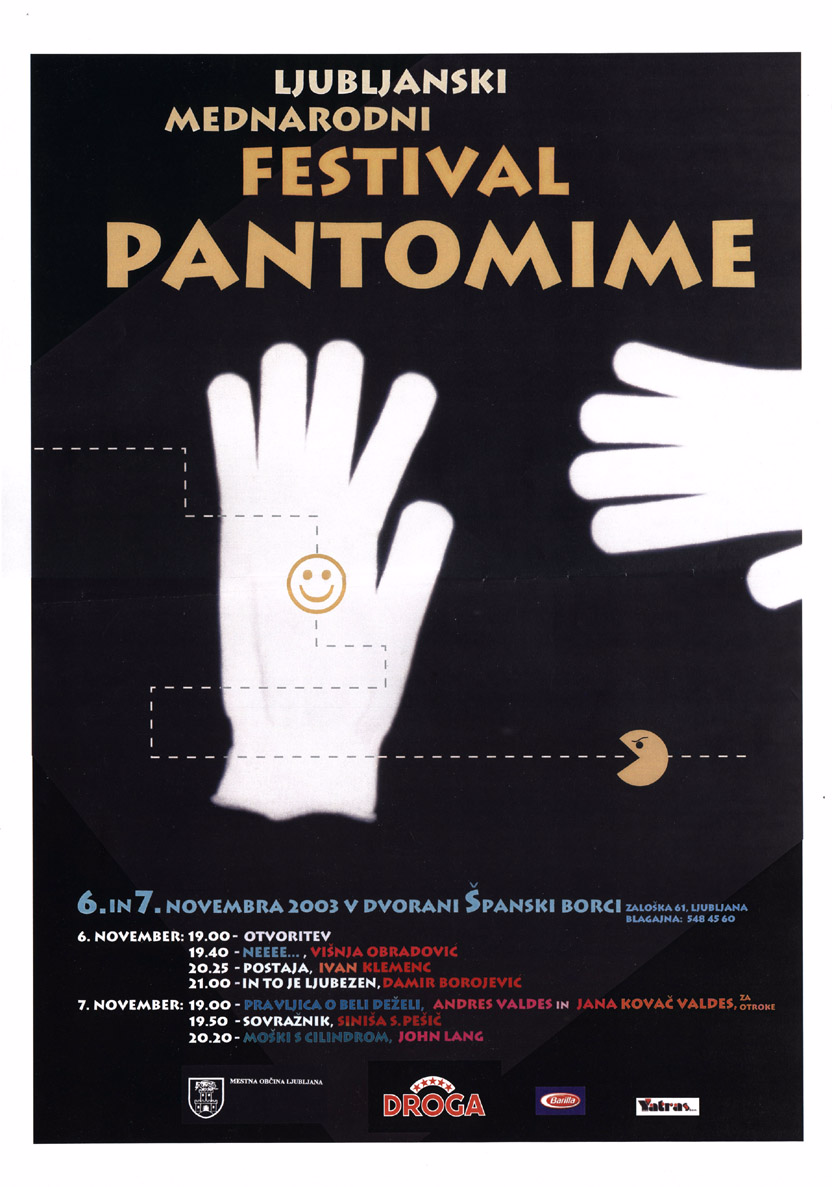Our school of mime includes active and intensive workshops and courses.
Based on a methodical approach of teaching and of creating interest.
Si-Nish Minardi, master of mime, has been teaching pantomime and mime since 2001.
He instructs adults, both amateur or professional actors, in the open mime studio, Studio Flow in Ljubljana and at the same time leads workshops for children and youth in the
School of Art for Children.
The mime course take places at Beethovnova Street in Ljubljana, Slovenia and it consist of concentrated classes in which we achieve results by a special methodological approach. Responding to the participient’s motivation, abilities and needs, they can learn the basic od mime and more advanced techniques of this skill.




- Princeples of acing
- 15. basic principles of pantomime acting
- Basic figure of mime
- Expressing the 5. Basic emotions and combining them
- Character of protagonist, behavior on the stage and becoming aware of our relationship with the audience
- 7. Defferent styles in mime
- Special breathing techniques in static and dynamic position during the play
- Becoming aware of inner and outer movement by leading yhe energy through and out of the body.
- Improving knowledge of theatre performance.
- Qualifications for teachers, for working with children.
- Becoming aware of body and mind through movement and scenic dramaturgy
- Ingenuity, the Gag and the Flash=Gag
- Completion of the preparing for the admittance exems for acting school or academy.
- You can say everything without words – mime in everyday life
- Micro dramaturgy and dinamics of movement*motion
- Developing a sense of humor and the obility to relax – catharsis through laughter.
- Expanding the expressive repertoire.
- Investigative play and discovering the true actor’s qualities and new direction in scenic expression.
- Strengthening the consciousness of how strong the movement of the body supports the texts of classical play and the story of the show itself.
- Learning the elements of acting, directing and dramaturgy through fun.
- Reaching self-discipline and the ability to concentrate on a certain object – efficient directing of attention.
- Mime and movement, return us back to our body, into breathing and yo a primal and entirely natural – healthy state.
- In plenty of many other activities, the life force direct us to positive things.
- Increasing awareness of the importance of development of the culture of movement for spiritual growth and health of young people.
- Corporeal movement as a way of expressing and experiencing freedom.
The prices list applay for one teaching meeting, which consists of 3 hours of work and can be (on your request) into more short meetings, visits. Usually we organized serial of meeting. Instructions can be given n your or our premises.
There are individual lectures or Group work (adults, youth and children). We will talk about level of instructions and prices feather. Thank you for join and expire our teaching program!

The program of learning consists of practical exercise, corroborated by theory.
It is divided in to 4. phases:
- Active=intensive relaxation with worming-up
- Learning the techniques of mime
- Guided and free improvisation
- Performing short acts with exercising the basic elements of directing of mime show.
1. Student’s lesson
- Inner movement direction – sympathy, antipathy and apathy,
- Use of the six senses.
- Enjoying and sensibility while we act: one has to feel every movement *except when directing requests otherwise.
2. Student’s lesson
- Breathing techniques in very dynamic positions, internal movement and breathing.
- Three sequences of initiating action on stage.
- Elements of mime acting, directing & micro-dramaturgy of movement
- Role of silence, p a u s e and quietness - constantly returning in silence and to basic body’s position.
3. Student’s lesson
- Improvisation as a skill of creating original art, from known elements to new ones, from an idea to action and realization.
- Continuous energetic intensity at the stage. MORE
- Visualization and self-suggestion.
4. Student’s lesson
- Combination of 7 different styles of non-verbal acting – mime.
- Self-discipline in movement.
- 3 Mime manipulations: 1) with imagine objects 2) with imagine persons 3) within play-building process.
5. Studnet’s lesson
- How to lead energy through and out of the body
- Nature of flash gag and attractivness of acting.
- Utilization of effects and sunts.
- Developing a sence of humor, irony and obility to relax – catharsis through laughter.
6. Studnet’s lesson
- The effect of continuous surprise.
- Combinig mime with dance, singing, ballet, improvisation, clwning, illusionisam and verbal acting.
- The effect of slow-motion, by performing th movement slowly we raiseawarness and deepen our and the viever’s perception!
7. Studnet’s lesson
- Gradaion when enacting emotion (energy transformation)
- Contrasts in acting, as: 1) change in dinamics/speed 2) change in intensity 3) change or combination of acting styles
4) Continuous tragicomedy.
- Tehnique of energy affirmation by lowering palm on a specific part of the body.
8. Studnet’s lesson
- Grydation when enlarging or diminishing objects (which we manipulate)
- Logic every change in movement must have a reason for the sake of story & message we would like to conwey.
- Drama conflict.
- Our energetic relationship with the audience.
All rights of this program reserved (c) Minardi Art., 2008.
SHARE THIS PAGE!